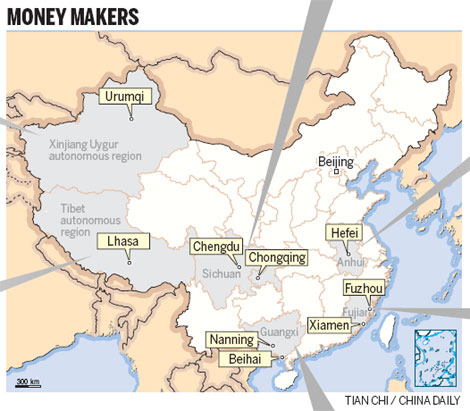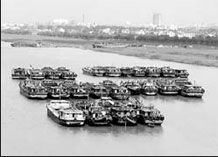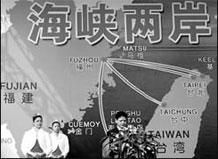China's future powerhouses

Regions set to be new driving force for the national economy
Xinjiang Uygur autonomous region

Xinjiang literally means "New Frontier", and it is promising to be a new economic frontier in China's northwestern areas. Xinjiang Uygur autonomous region has abundant oil reserves and it is the largest natural gas-producing region in China. An economic development plan for Xinjiang is expected to come out soon. It will emphasize use of Xinjiang's advantageous resources, including petrochemicals, coal, non-ferrous metals and agriculture. The investment is likely to rise steadily over the next three years, driven by increased financial support from central government and neighboring provinces, and large-scale investment for key projects from State-owned companies. The rising tourism industry will also be a contributor to Xinjiang's economic growth.
Tibet autonomous region

The Tibet autonomous region is becoming another hotspot in China's regional economic development. The plateau region was traditionally dependent on farming and herding. Recently Tibet laid out a plan to explore its mineral resources, while pledging to stick to rational exploitation and minimizing the damage to the natural environment. The government announced plans to achieve "leapfrog development" in Tibet in January, including building the region into a "strategic reserve of natural resources" with the aim of reducing poverty among the Tibetan people. Tibet has more than 3,000 proven mineral reserves and it has China's biggest proven chromium and copper deposits. According to the plan, mineral resources will contribute at least 30 percent to the regional GDP over the next 10 years. Tourism will continue to play a significant role in supporting the economy.
Chengdu-Chongqing Economic Zone

Chengdu, capital city Southwest China's Sichuan province, and Chongqing, one of China's four municipalities, is becoming another economic driving force and will be one of the major national economic zones as part of China's efforts to develop the less developed western areas. The National Development and Reform Commission has drafted development plans for the Chengdu-Chongqing Economic Zone, which includes 15 cities in Sichuan province and 31 districts and counties in Chongqing and covers a total area of about 200,000 square kilometers. China's first inland bonded port is under construction in Chongqing.
Beibu Gulf Economic Zone

China and the Association of Southeast Asian Nations (ASEAN) have established the world's largest free trade area of developing countries. The Beibu Gulf Economic Zone in Southwest China's Guangxi Zhuang autonomous region has been underlined as a critical area for regional economic cooperation thanks to its geographic proximity to ASEAN countries. It consists of six cities, Nanning, Beihai, Qinzhou, Fangchenggang, Chongzuo and Yulin, with a landmass of 42,500 square kilometers and a population of more than 12 million. Guangxi is located in the core of Beibu Gulf. The State-approved zone will be a hub with ASEAN economies.
Wanjiang River Urban Belt

The Wanjiang River Urban Belt of Anhui province is the first and only area that has been approved by the central government as a national-level industrial transfer demonstration zone. It has been given priority to "act first and try first" by central government and was positioned as an important driving force for central China's economic growth and a base for advanced manufacturing and services. With its geographical advantages and comprehensive competitiveness in cost and industrial base, the area is a good choice for companies based in the Yangtze River Delta that want to transfer or expand to other areas. Equipment manufacturing, raw material industry, textiles, high technologies, modern services and modern agriculture have been highlighted as six pillar industries. The zone includes nine cities and two counties, and Hefei and Wuhu will be two core leaders. It's expected that by 2015 the area's gross domestic product (GDP) will double that of 2008.
Economic Zone on the West Coast of the Taiwan Straits

Centered on Fujian province, the Economic Zone on the West Coast of the Taiwan Straits faces Taiwan province to the east, adjoins the Yangtze River Delta to the north, and neighbors the Pearl River Delta to the south. Fujian province will initially be the major center but it will also include a few neighboring provinces including Guangdong and Zhejiang. As well as geographic proximity, the region shares the same ancestral origins, languages, culture and traditions with Taiwan province. The zone is expected to be a new channel to promote cross-Straits cooperation on a larger scale. Besides furthering its business ties with Taiwan, the zone will enable the construction of a national center for tourism and allow full enjoyment of its scenic spots, such as Wuyi Mountain, Gulang Islet, and also further the common cultures across the Straits including Min Nan (southern Fujian), Hakka and Mazu.
(China Daily 03/22/2010 page14)














